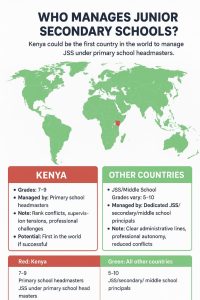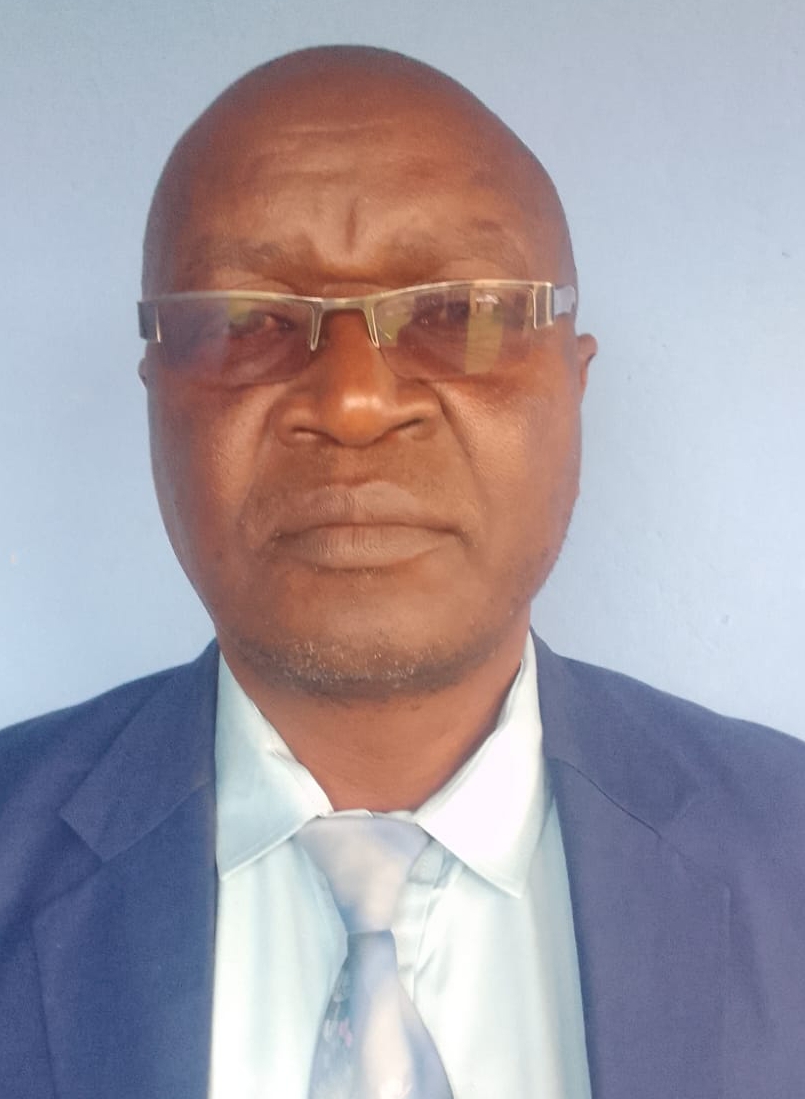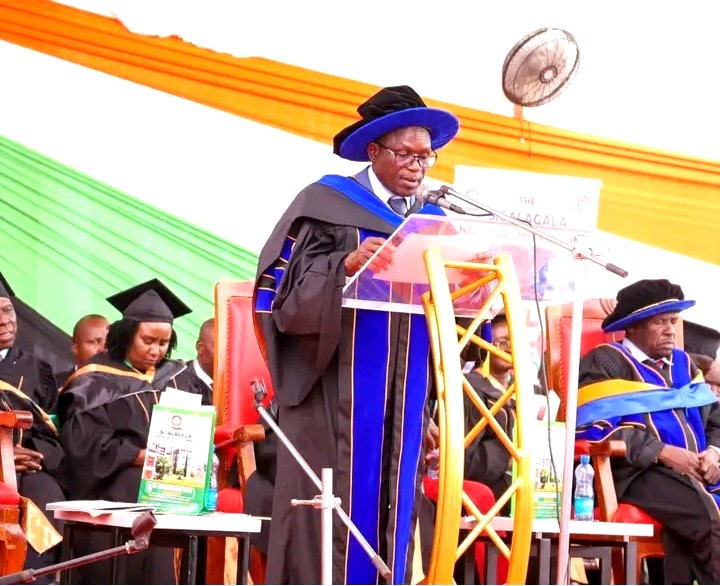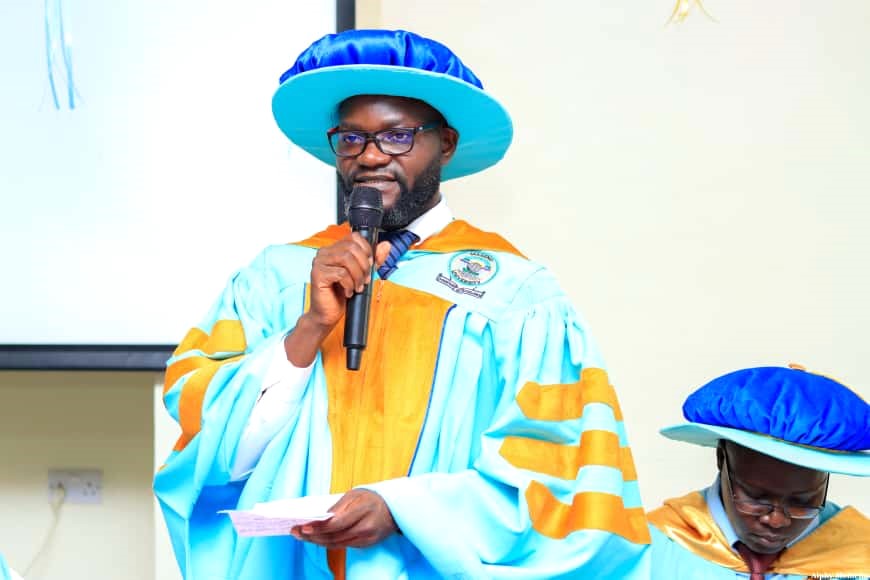Kenya’s education system is at a crossroads. The introduction of Junior Secondary Schools (JSS) under Competency-Based Education (CBE) has created new opportunities for learners, but it has also exposed administrative and professional tensions. While teachers from colleges and experienced primary school educators work together effectively, challenges arise from unclear leadership structures and rank disparities under primary school headteachers. How Kenya navigates this unique transition could set a global precedent for integrated school management.
Across Kenya, a subtle but persistent tension exists between Junior Secondary School (JSS) teachers and primary school headteachers — a tension that shows no sign of fading. What was initially considered a temporary adjustment has evolved into a long-term professional standoff, exposing deep structural, administrative, and human challenges within the country’s education transition.

The Changing School Environment
Primary school headteachers have long been the legitimate authorities within their institutions, commanding respect over curriculum, discipline, and resource management. But a “newborn baby” called JSS has arrived — a phase introduced under Competency-Based Education (CBE) and staffed with teachers trained at the secondary level. This has brought new dynamics, expectations, and realities into the traditional primary school environment.
The Composition of the JSS Workforce
Kenya currently has approximately 83,129 JSS teachers actively engaged in Grades 7, 8, and 9. This includes 48,550 permanent and pensionable teachers, 8,378 redeployed P1 teachers, and around 20,000 intern teachers hired in 2025. Despite this, the Teachers Service Commission (TSC) notes a shortfall of about 72,422 teachers, highlighting the urgent need for additional recruitment. Plans are underway to hire 24,000 more intern teachers by January 2026, bringing the total workforce to over 107,000. By 2027, the goal is to employ 116,000 teachers to meet the requirements of the Competency-Based Education framework.
Within this workforce, a clear distinction exists: around 12,000 senior teachers were elevated from primary schools after meeting the requisite qualifications, now serving in job groups C3, C4, C5, D1, and D2. They bring valuable classroom experience, institutional memory, and mentorship capacity. Meanwhile, approximately 60,000 newly recruited teachers from colleges serve mainly in C2 and C3.
Importantly, there is no conflict between these two categories of JSS teachers. The experienced teachers mentor younger colleagues, while recruits bring fresh energy and ideas to classroom delivery. Together, they represent a promising blend of experience and innovation. The real tension lies not within the JSS workforce but in the administrative structures under which they operate.
A Question of Authority and Legitimacy
At the heart of the standoff is a struggle for authority and professional recognition. JSS teachers believe their training and qualifications grant them autonomy in curriculum delivery and learner assessment. On the other hand, primary school headteachers insist that, as institutional heads, they remain legally responsible for the entire school, including the JSS section.
Salary and rank disparities worsen this delicate balance. A C2 JSS teacher may report to a C5 headteacher, while a D1 or D2 senior JSS teacher may technically outrank the headteacher. Even headteachers in C3 or C4 remain legitimate leaders, as such variations arise from normal administrative gaps. These inconsistencies have occasionally led to friction over timetables, lesson supervision, discipline, and management of capitation funds.
Headteachers’ Experience and Training Since Receiving the Mandate
Kenya’s primary school headteachers are appointed based on a combination of academic qualifications, professional experience, and leadership training, ensuring they are well-equipped to manage schools and oversee initiatives like JSS under Competency-Based Education.
Academic Qualifications:
To be eligible for appointment, candidates must hold at least a Primary Teacher Education (PTE) certificate or a Bachelor’s degree in Education or its equivalent, providing a strong foundation in educational theory and practice.
Professional Experience:
Candidates are generally required to have served as deputy headteachers for a minimum of three years, gaining practical experience in school operations, administration, and instructional supervision.
Leadership and Professional Training:
Headteachers undergo extensive leadership development through programs such as:
Kenya Education Management Institute (KEMI) programs focus on school leadership, instructional supervision, curriculum management, and resource allocation
Teacher Professional Development (TPD), strengthening leadership, mentoring, and strategic planning skills.
Specialised workshops and seminars addressing CBE implementation, learner assessment, and effective school management practices.
Appointment and Oversight:
The Teachers Service Commission (TSC) oversees appointments, requiring headteachers to submit letters of appointment, certificates of good conduct, and clearance from the Higher Education Loans Board (HELB), ensuring only qualified candidates assume leadership.
This combination of academic credentials, professional experience, and leadership training equips headteachers to guide schools effectively, supervise JSS teachers, and maintain harmony while implementing the CBE framework.
Beyond Autonomy: The Broader Role of JSS Teachers
While professional autonomy is important, the effectiveness of JSS teachers depends on several additional responsibilities that extend far beyond independent classroom management. They are tasked with:
Curriculum Implementation: Delivering the Competency-Based Education syllabus effectively, adapting lessons to meet diverse learner needs, and ensuring learning outcomes are achieved.
Mentorship and Collaboration: Working closely with colleagues, including senior teachers and primary headteachers, to foster a culture of shared learning and professional growth.
Learner Assessment and Guidance: Conducting fair and comprehensive learner evaluations, providing feedback, and supporting students’ personal and academic development.
Innovation and Resourcefulness: Applying creative teaching methods, integrating technology, and using available resources efficiently to improve learning outcomes.
Professional Conduct and Ethics: Maintaining high standards of discipline, integrity, and accountability in interactions with learners, parents, and colleagues.
School Development Participation: Contributing to school-wide initiatives, planning, and decision-making processes that enhance overall institutional performance.
In essence, the role of a JSS teacher combines pedagogical expertise, mentorship, leadership, innovation, and ethical responsibility, making them crucial partners in ensuring the success of the Competency-Based Education system — not just autonomous operators within the classroom.
The Role of TSC and Unions
The Teachers Service Commission (TSC) has adopted a cautious and consultative approach to resolving the standoff. Rushed decisions could destabilise the delicate balance between JSS teachers and primary headteachers, worsening the situation instead of healing it. By engaging stakeholders patiently, the TSC aims to develop a fair and sustainable framework that balances the need for administrative authority with the preservation of professional dignity.
However, teacher unions have adopted divergent positions. KNUT has sided mainly with primary headteachers, citing their statutory mandate as school managers, while KUPPET has championed JSS teachers, demanding autonomy and recognition of their secondary-level training. This ongoing tug-of-war has further complicated the path to stability and understanding.
A Call for Sobriety and Patience
Education reform is never a smooth process — not even in the most developed countries. No system is flawless; every reform comes with its share of growing pains. Kenya’s challenges began at the rudimentary stage of implementation. Therefore, it is neither fair nor productive to blame JSS teachers, the TSC, the Ministry of Education, unions, headteachers, or even the Presidential Working Party.
Blame games only worsen an already fragile situation. Our universities also took time before they could begin training teachers under the new Competency-Based Education framework. The transition demands patience, mutual understanding, and steady collaboration among all education stakeholders.
This is the moment for policymakers to exercise their wisdom and skill in steering the education system out of its current mess. It requires patience, sober reflection, and deliberate action that prioritises long-term solutions over short-term fixes.
Global Lessons on JSS Management
Kenya is not alone in implementing a junior secondary or middle school model. However, in all other countries where JSS or its equivalent exists, management is not placed under primary school headteachers.
Ghana: JSS (Grades 7–9) is managed independently under JSS headteachers.
Nigeria: JSS (Grades 7–9) is managed by principals under state or federal authorities.
South Africa: Grades 8–9 fall under secondary schools led by secondary school principals.
In the United States, middle schools (Grades 6–8) are typically managed by middle school principals within school districts.
Germany: Lower secondary schools (Grades 5–9/10) are managed independently by principals.
In India, middle schools (Grades 6–8) fall under the management of secondary schools.
Japan: Junior high schools (Grades 7–9) are managed by junior high principals under local boards of education.
Brazil: Lower secondary (Ensino Fundamental II, Grades 6–9) are managed independently.
France: Collèges (Grades 6–9) are managed by Proviseurs, separate from primary schools.
Australia: Middle or junior secondary phases (Grades 7–9) are led by secondary school principals.
Canada: Middle schools (Grades 6–8 or 7–9) are managed by secondary-level principals.
United Kingdom: Key Stage 3 (Grades 7–9) is part of secondary schools, independent of primary leadership.
Singapore: Lower secondary education (Grades 7–10) is managed within secondary schools under the supervision of school principals.
In all these countries, primary headteachers do not supervise JSS teachers, ensuring clear administrative structures, reducing professional conflicts, and allowing junior secondary education to operate as a distinct, autonomous phase.
Kenya’s Unique Opportunity
Unlike these countries, Kenya currently places JSS within primary school premises under primary headteachers. This structure has naturally created administrative tension over supervision, rank disparities, and professional recognition.
READ ALSO:
Industry partnership drives TVET graduate employment to 80 percent in East Africa
Yet, if Kenya succeeds in making this model work — by fostering collaboration, mutual respect, and a well-defined administrative framework between primary headteachers and JSS teachers — it will become the first country in the world to manage Junior Secondary under primary school leadership while maintaining educational quality and harmony.
Such success would not only resolve Kenya’s internal challenges but also set a new global precedent, offering a model of integrated school management that blends tradition, innovation, and shared responsibility.
Competency-Based Education (CBE) remains one of the most effective learning models globally — practical, learner-centred, and skill-oriented. If implemented responsibly and supported through sound policy, sufficient resources, and professional cooperation, it has the potential to transform Kenya’s education system and produce a generation of learners ready to thrive in a rapidly changing world.
By Hillary Muhalya
You can also follow our social media pages on Twitter: Education News KE and Facebook: Education News Newspaper for timely updates.
>>> Click here to stay up-to-date with trending regional stories
>>> Click here to read more informed opinions on the country’s education landscape





